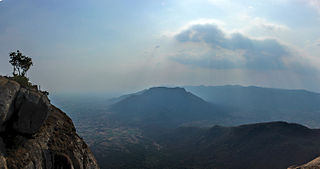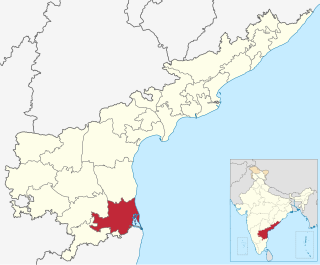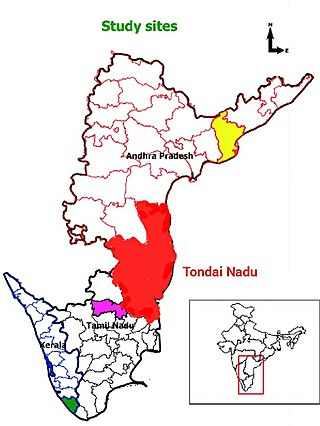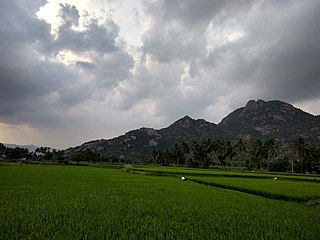
Arcot is a town and urban area of Ranipet district in the state of Tamil Nadu, India. Located on the southern banks of Palar River, the city straddles a trade route between Chennai and Bangalore or Salem, between the Mysore Ghat and the Javadi Hills. As of 2018, the city had a population 129,640. The sweet makkan peda is a local speciality while Arcot biryani, a rice-based traditional food, is also served here.

Chittoor is a city and district headquarters in Chittoor district of the Indian state of Andhra Pradesh. It is also the mandal and divisional headquarters of Chittoor mandal and Chittoor revenue division respectively. The city has a population of 153,756 and that of the agglomeration is 175,647.

Palar is a river of southern India. It rises in the Nandi Hills in Chikkaballapura district of Karnataka state, and flows 93 kilometres (58 mi) in Karnataka, 33 kilometres (21 mi) in Andhra Pradesh and 222 kilometres (138 mi) in Tamil Nadu before reaching its confluence into the Bay of Bengal at Vayalur about 75 kilometres (47 mi) south of Chennai. It flows as an underground river for a long distance only to emerge near Bethamangala town, from where, gathering water and speed, it flows eastward down the Deccan Plateau. The Towns of Bethamangala, Santhipuram, Kuppam,Mottur, Ramanaickenpet, Vaniyambadi, Ambur, Melpatti, Gudiyatham, Pallikonda, Anpoondi, Melmonavoor, Vellore, Katpadi, Melvisharam, Arcot, Ranipet, Walajapet, Kanchipuram, Walajabad, Chengalpattu, Kalpakkam, and Lattur are located on the banks of the Palar River. Of the seven tributaries, the chief tributary is the Cheyyar River.

The Javadhu Hills are an extension of the Eastern Ghats spread across parts of Tirupattur and Tiruvannamalai districts in the northern part of the state of Tamil Nadu in southeastern India. This range separates Tirupattur and Tiruvannamalai districts. Tirupattur district lies on the north-western side and Tiruvannamalai district lies on the south-eastern side of this range. The towns of Tirupattur, Vaniyambadi and Ambur of Tirupattur district are located on the north western side and the towns of Chengam and Polur of Tiruvannamalai district are located on the south eastern side.

Sholinghur is a municipality under Sholinghur taluk in Ranipet District of Tamil Nadu, India. The town is famous in Tamil Nadu and other neighboring states for the Lakshmi Narasimha Swamy temple.

Chittoor district is one of the eight districts in the Rayalaseema region of the Indian state of Andhra Pradesh. It has a population of 18,72,951 according to 2011 census of India. It is a major market centre for mangoes, grains, sugarcane, and peanuts. The district headquarters is located at Chittoor.
Arani, officially spelled as Arni and also known as Periya arani, is a major commercial, industrial and cultural hub and also a divisional headquarter in the Tiruvanamalai district of Tamil Nadu, India. The town is the second largest urban center next to the district headquarters, Tiruvannamalai, and is administered by a selection grade municipality. Arni is home to silk weaving, spinning mills and agricultural industries. Famous Arni silk and a paddy variety named Arni Ponni, known for its rich aroma, originates from Arni. The town is often nicknamed as The Silk City. Arni also has a rich cultural heritage as it is a major center of Tamil Jainism.

Shorea tumbuggaia is a species of plant in the Dipterocarpaceae. It is native to Andhra Pradesh and Tamil Nadu in India. The species is found widely in Seshachalam and Veligonda hills in Cuddapah and Tirupati hills of Chittoor district of Andhra Pradesh to North Arcot and Chingleput, districts of Tamil Nadu.
Talakona is situated in Tirupati district of Andhra Pradesh, India. It is a resort with waterfalls, dense forests and wildlife. Talakona waterfall is in Sri Venkateswara National Park, Tirupati district of Andhra Pradesh. With a 270 feet (82 m)-fall, Talakona is the highest waterfall in Andhra Pradesh state. Talakona is also known for the Lord Siddheswara Swamy Temple, which is located close to the waterfall.

The Roman Catholic Diocese of Vellore is a diocese located in the city of Vellore in the Ecclesiastical province of Madras and Mylapore in India.

Tirupati Eparchaean Unconformity, a notified National Geo-heritage Monument is a major discontinuity of stratigraphic significance that represents a period of remarkable serenity in the geological history of the Earth i.e. sudden changes and discontinuity in the rock layers in Earth's crust. It is seen at the steep natural slopes, road scars and ravines in the Tirupati – Tirumala Ghat road in Tirupati district of Andhra Pradesh, India.
The Venkatagiri estate was an estate in the erstwhile Madras Presidency. It was located in the Nellore district of the present-day Andhra Pradesh. The town of Venkatagiri was the administrative headquarters.

The Madras Presidency was a province of British India comprising most of the present day Tamil Nadu and Andhra Pradesh along with a few districts and taluks of Karnataka, Kerala and Odisha. A few princely states, notably Ramnad and Pudukkottai also merged into the Presidency at some or the other time. The Presidency lasted till 1950, when it became the Madras State after India became a republic. In 1953, Telugu-speaking regions of the state split to form Andhra State. Subsequently, in 1956, Kannada- and Malayalam-speaking areas were merged with Mysore and Travancore-Cochin respectively.

South Arcot District was a district in the Madras Presidency of British India. It covered the area of the present-day districts of Cuddalore, Kallakurichi and Viluppuram in the Indian state of Tamil Nadu. The district was divided into eight taluks and covered a total area of 13,510 square kilometres (5,217 sq mi). The administrative headquarters was the town of Cuddalore.

Tiruvannamalai district is the largest and one of the 38 districts in the state of Tamil Nadu, in South India. It was formed in the year 1989 through the bifurcation of North Arcot into the Tiruvannamalai Sambuvarayar and Vellore Ambedkar districts. The city of Tiruvannamalai is the district headquarters.

The Districts of British India were administrative units of the Government of the British Raj or Indian Empire. Districts were generally subdivisions of the provinces and divisions of British India
Sakkaramallur is an Indian village panchayat located in Arcot Taluk of Vellore District in the state of Tamil Nadu. Sakkaramallur is located on Right Bank of Palar River.

Tondaimandalam, also known as Tondai Nadu, is a historical region located in the northernmost part of Tamil Nadu and southernmost part of Andhra Pradesh. The region comprises the districts which formed a part of the legendary kingdom of Athondai Chakravarti. The boundaries of Tondaimandalam are ambiguous – between the river basins of Penna River and Ponnaiyar River. During the reign of Rajaraja I, this region was called as Jayankonda Cholamandalam.

Kallakurichi is one of the 38 districts in the state of Tamil Nadu in India. The district headquarter is Kallakurichi. Kallakurichi District was announced on 8 January 2019 and it came into existence on 26 November 2019.
















